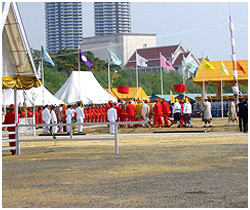Observation of the ceremony in Thailand dates back to the Sukhothai period. Nonetheless, the event lost its festive zeal, until King Bhumibol Adulyadej revived it in 1960. Therefore, rice grown on the Chitralada Palace grounds, home of King Bhumibol Adulyadej, is planted in the ceremony by appointed court Brahmins. The King then initiates the ceremony by ploughing the ground and offers farmers his blessings for a productive harvest.
 Considered as auspicious, these seeds are then
collected on completion of the ceremony by farmers, who either mix them
with their own stock or keep them as propitious charms.
Considered as auspicious, these seeds are then
collected on completion of the ceremony by farmers, who either mix them
with their own stock or keep them as propitious charms.Once the ceremonial ploughing is over, two sacred bulls tethered to a wooden plough are offered seven different platters of food, comprising of rice, corn, green beans, sesame, fresh-cut grass, water and rice whisky. Depending on the bulls' choice of food, court soothsayers make a prediction on the agricultural produce for that particular year. During the ceremony, the King also encourages agricultural production by presenting various awards and certificates to meritorious farmers whose fields had yielded highest amounts of produce during the previous year.



